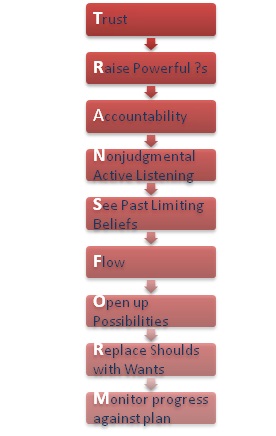A Coaching Model Created by Elyssa Herman
(Executive Coach, United States)
What is a coaching model?
A coaching model is a visual representation of the framework a coach uses when working with clients. It helps to break down the process in a meaningful way so that clients can understand the methodology of the coaching sessions.
My coaching model is called TRANSFORM
Transform means to make a thorough or dramatic change in the form, appearance, or character of. A synonym often used is metamorphosis, like a caterpillar turning into a butterfly. When clients come to me, they come for a reason. They want a change in at least one aspect of their lives. Through this model, my goal is to watch my clients transform and live the life of their dreams.
 This 9 Step model is comprised of the following steps:
This 9 Step model is comprised of the following steps:
 T – Trust
T – Trust
By setting a strong foundation and coaching contract, the client will understand the confidentiality of each session, the safe space established for them, the ICF Code of Ethics being followed, and the agreed upon contract between us. This will set the foundation for building a trusting relationship, which is paramount to a successful coaching/client arrangement.
R – Raise Powerful Questions
Asking powerful open-ended questions based on the goals the client sets forth for the session to help progress the session forward, while allowing the time and space for the client to reflect on answers to those questions. Powerful questions should lead a client towards the goal they are hoping to achieve. Sometimes this involves making a plan of action; other times, a brainstorming session to get clarity is what is needed.
A – Accountability
Holding the client accountable for the actions they say they will take is extremely important. This includes following up with them on these actions to see what progress they have made. Where progress they have stated they will make has not been made when they said it would be made, it is key to dig into what might be getting in the way of their progress, through the use of powerful questions.
N – Non-judgmental Active Listening
Actively listening to the client means giving the client the time and space they need to convey what is going on for them and mirroring back to them what is understood to be the main message they are conveying, using their own words. It also means listening not only to the words they use, but also to the tone, speed, and attitude behind the words used.
S – See past limiting beliefs
Through powerful questioning, a client often can identify a belief or a pattern of beliefs that limit their possibilities of reaching their goals. A coach will ask powerful questions to help bring these to the forefront so that work can be done through visualization, reframing and other tools to create new possibilities.
F – Flow
The pace of a session will be based on the pace of how the client shows up that day. It is incumbent upon a coach to follow the pace of the client and to allow for movement and flow in each session.
O – Open up possibilities
A coach, through active listening, will hear what is being said and also hear what the client may not be saying. It is important for the coach to keep and maintain a positive approach and to encourage their client to see possibility and choice in all situations.
R – Replace “shoulds” with “wants”
Living the life you want means understanding what the “shoulds” are that are holding you back. Understanding the “shoulds” which form the client’s belief system and unraveling them where they don’t serve the client is a key part of creating possibilities and reaching desired goals.
M – Monitor progress against plan
It is important to continually revisit goals to make sure progress is being made in the right direction set by the client. Where progress is not being made, it is important to re-evaluate goals and re-work them where they are no longer the right goals.
